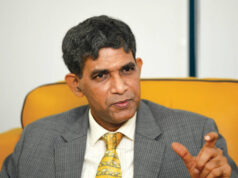 NEW YORK – A book, with the potential of becoming popular reading material on India, hit the stands a few weeks back in the United States.
NEW YORK – A book, with the potential of becoming popular reading material on India, hit the stands a few weeks back in the United States.
The book called “India Connected: How the Smartphone is Transforming the World’s Largest Democracy” (Oxford University Press; Published: 01 November 2018; 240 Pages) has been written by Ravi Agrawal, the managing editor of US-based Foreign Policy magazine and Asia Society’s Asia 21 Young Leaders Initiative.
Agrawal, who was participating in a lively panel discussion at the Asia Society in New York on Wednesday under the theme “The Future of India: Perspectives from a Younger Generation”, underscored the power of India’s population of young people.
The other panelists included James Crabtree, currently associate professor at the Lee Kuan Yew School of Public Policy in Singapore (he spoke live from Singapore via television); Arundhati Katju an Indian lawyer, who heads her own law offices since 2011 and regularly acts as a barrister for leading Indian law firms, having represented clients in India, Germany, Singapore and the US, and Somini Sengupta, The New York Times’ international climate reporter, who moderated the discussion.
Agrawal who also briefly spoke to Bernama after the event pointed out that as India braced for the upcoming general election in the spring of 2019, political parties are paying special attention to India’s young demography – 50 per cent of its population is below the age of 25.
Over 130 million first-time voters will be casting ballots this election, a staggering number for any campaign strategist.
But it was the tiny gadget called the smartphone in the hands of Indians that was transforming India.
“In India, the smartphone is more than just a convenient way to check Facebook: It is a tool for the evening playing field and catching up with the rest of the world – a revolutionary idea in the world’s largest democracy,” Agrawal said.
“For most Indians, the internet is something that they are only discovering right now, and not through personal computers [the way that many in the West did]. Most Indians never have had PCs, and never will have PCs,” Agrawal maintained.
For many Indians, the phone is their first mobile device – and Agrawal emphasised that it is much more than just a phone.
“For someone making two thousand dollars a year, it could be your first TV screen. It could be your first mp3 player or your first Walkman. In most cases your first camera, maybe even your first alarm clock, your first compass, your first map device, your first GPS enabled device.”
The numbers are hard to ignore. According to Agrawal, there are about 400 million Indians on the internet today. That number is expected to reach one billion as soon as 2025.
The existence of so many Indians online will have a ripple effect into various industries, potentially transforming the country’s interpersonal relationships, education system, economics, and politics.
For example, smartphones have given rise to India’s booming dating app industry. While the American apps such as Tinder operate in the country, homegrown services like TrulyMadly and Woo have dominated market share.
But the uses of a smartphone can be even more profound. According to the country’s last census, India had about 270 million people classified as illiterate. The capabilities of the smartphone, with touchpads and voice recognition, suddenly provided access to a world that was once out of reach.
“I’ve been to villages in India where women who are illiterate can take a phone, press Google Talk, and just say, ‘show the Taj Mahal,’ and a video pops up and they can press play and see moving images of the Taj Mahal in a way that really wasn’t possible before.
“They can look at videos of how to cook different types of dishes and how to make new shalwar kameez’s to boost their stitching businesses. These are things that were just not imaginable even five or 10 years ago for vast parts of Indian society.”
— BERNAMA










